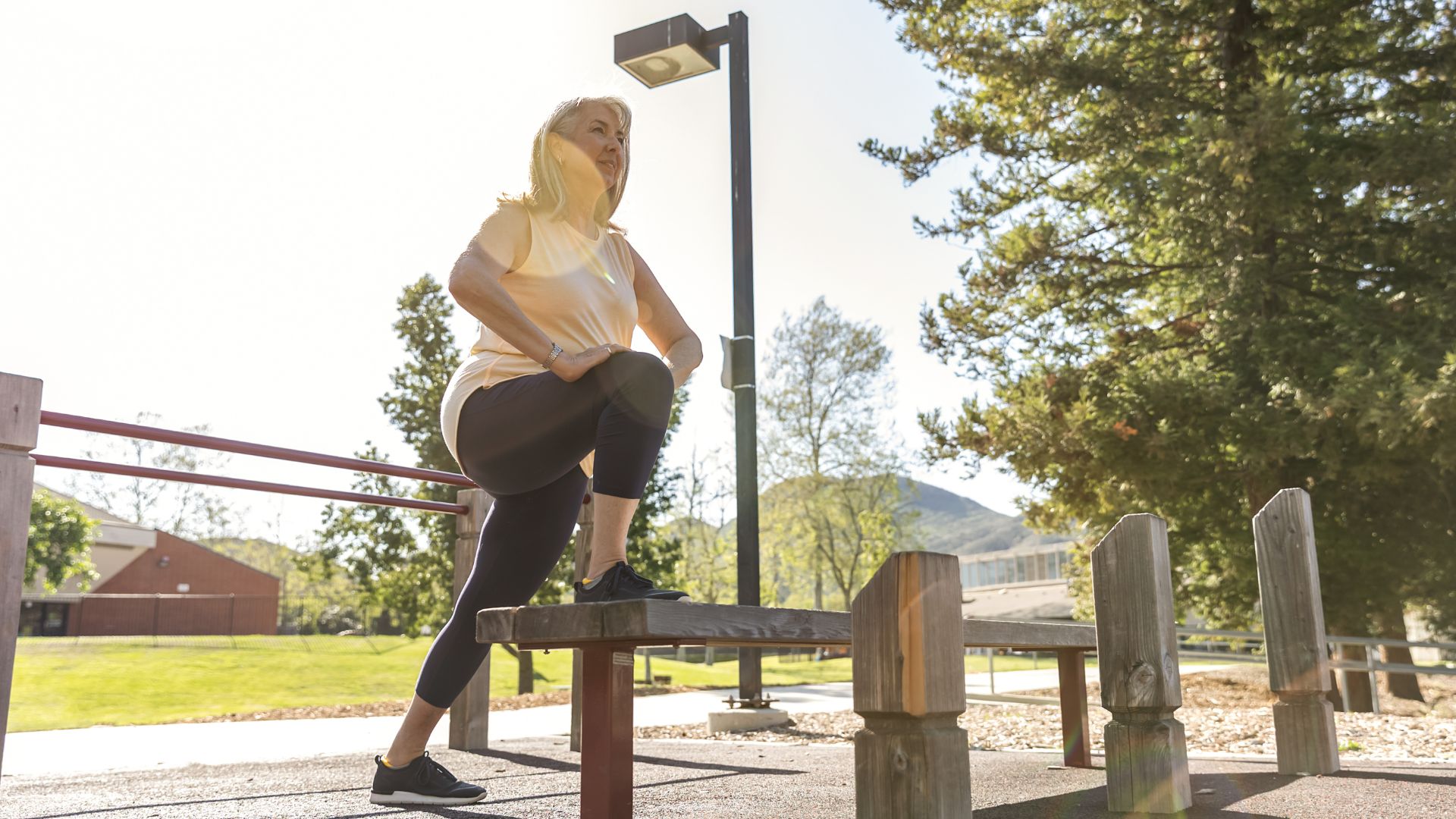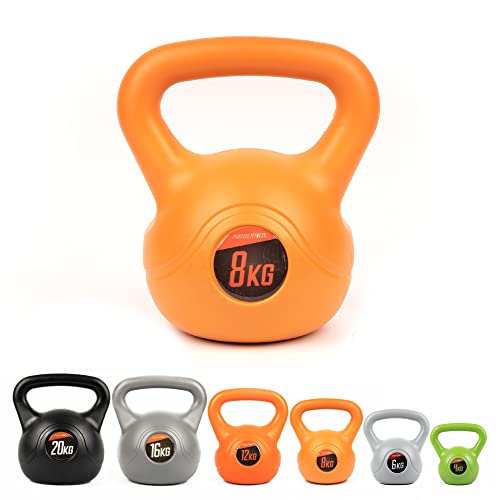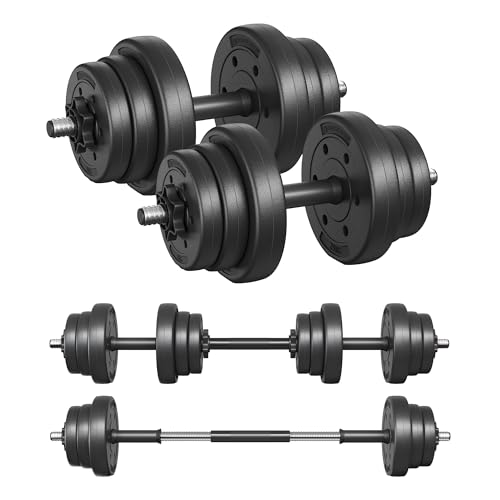Swap squats for step-ups and thank me later - they are 'even better' for building lower-body strength
The step-up exercise builds strength one leg at a time, improving balance, stability and helping to build muscle like no other exercise


Exercises like squats have their place in a workout, but most of us have imbalances in lower-body strength, prioritising one leg over the other during gym workouts, cardio sessions, and even walking around in daily life, because it is stronger.
The step-up exercise corrects this, as you use your body weight as resistance (with dumbbells to make it harder) and lift yourself onto a chair or bench, one leg at a time. It's a movement that targets the entire lower body, from ankle stability to core strength, and it can be done almost anywhere.
So, it's no surprise that personal trainers and physiotherapists recommend the step-up exercise in most types of strength training workouts.
What is the step-up exercise?
Step-ups work the quads, hamstrings, glutes, and core, making them a strong choice for people aiming to build functional strength and improve balance and stability, says Tash Gale, a chartered physiotherapist and the founder of Gale Physio.
Often, one of our legs is stronger than the other. If you regularly hike, run, or cycle, you could have an imbalance. The step-up exercise can help correct this, she adds. In this way, they can be even better than squats.
But the key is to do the exercise correctly, warns Harriet Harper, a certified personal trainer and strength specialist. "Don't push yourself off the floor with your non-working leg or foot. Also, try to avoid pulling yourself up. A light tap on the floor is fine, but then use your working leg to drive up."
Want to swap out your walking lunges and try something new? Here, PT Harriet and physio Tash, who also works with Physique, explain how to do the step-up exercise, its benefits, and the variations to try.
Sign up to our free daily email for the latest royal and entertainment news, interesting opinion, expert advice on styling and beauty trends, and no-nonsense guides to the health and wellness questions you want answered.
How to do step ups
- Put a stable chair or bench in front of you, or use your stairs.
- Hold onto something or rest your hand against the wall for support.
- Place one foot on the chair, then push through that foot to lift your body up towards the ceiling.
- Bring your back foot up onto the flat surface as well.
- Hinge the hips back as you lower yourself back down, leading with your first foot.
- When lowering yourself back down, make sure to move in a controlled way, keeping your glutes under tension.
Tips for doing step-ups correctly
- Get your set-up right: Try to keep the front shin vertical (the shin of the working leg), says Harper.
- Think about your form on the way down: "Really think about pushing the hips back and getting a good stretch to the glute muscle on the way down," she says.
- Don't 'drop' yourself: "Try not to 'drop' down to the floor with no control," says Harper. The muscles are worked just as much on the way down as they are on the way up.
What are step up exercises good for?
1. Building glute strength
Provided you do the step-up exercise right, it's seriously beneficial for building strength in the glutes (buttocks).
"The height of the box allows for a really good 'stretch' in the glute on the way down and a great range of motion," explains Harriet. It's also one of the great quadriceps exercises to try.
2. Building a stronger core
Step-ups are one of the more underrated core exercises. It works key muscles in this area, like the abs, obliques, and lower back, as you stop yourself from toppling sideways.
While it's no match for specific movements like the dead bug or plank, the exercise is a great one to have in any bodyweight workout.
3. Improving balance and stability
The step-up exercise is a good example of why weights win the debate of free weights vs machines for building strength. The elevation and demand of the single leg movement in this exercise force the body to stabilise itself, improving full-body balance and stability.
These improvements are transferable to everyday life - think standing on a chair to reach something above the kitchen cupboards, getting up onto a ladder in the garden, or generally moving around without support later in life.
4. For beginners to build strength
If you're getting into strength training for beginners at home, the step-up exercise is a must-try as part of a bodyweight workout.
"It's still fantastic if you don't have weights," agrees Harper. "But make sure you practice correct form and slow down the tempo to get the most out of the movement."
5. For progressive overload
Progressive overload (making an exercise progressively harder through increased weight, repetitions, or another way to continually challenge yourself) is essential for anyone looking to get stronger.
It's very easy to make small adjustments to the step-up exercise and achieve progressive overload. You don't even need to add weights to do this, says Tash.
"A higher platform increases the range of motion and requires more strength from the working leg," says the physio. "Just be sure to keep the knee alignment and biomechanics, and ensure you avoid using momentum to swing yourself up."
How long should you do step-ups for?
If you want to get stronger, it's a good idea to aim for three sets of step-ups, with six to 12 repetitions on each leg. This can take anywhere from 10 to 20 minutes, depending on how much you need to rest between your sets.
Naturally, if you're new to strength training, you may need to start smaller and work your way up. For example, try doing five or 10 repetitions every day. When that feels easy, you can add more repetitions or more sets.
If you're in doubt about how to make your workout harder or how to include the step-up exercise in your routine, consult a personal trainer.
Step up variations
Step ups with weights
Step-ups can be done with dumbbells, kettlebells, a cable machine, or a Smith machine, says Harriet, so it's very easy to add weights to your exercise.
"I would recommend beginners try with body weight to begin with, and only introduce weight once they are confident with their form," says Harriet. "You also only really need one dumbbell or kettlebell, as you will be using one hand to hold onto something."

Available in a range of weights from 4 to 20kg, a vinyl kettlebell like this one adds resistance to your lower body, making it work harder. As the centre of the weight is lower in a kettlebell vs dumbbell, you might find it's easier to use for this exercise.
Lateral step ups
A lateral step-up targets the glute medius (a muscle in the upper buttocks) more so than forward step-ups because it's a side-to-side movement. "This muscle is crucial for pelvic and hip stability and injury prevention. It also forces each leg and hip to work independently, which highlights and helps correct imbalances between your left and right sides," says Tash.
To do a lateral step-up, follow the same movement as the forward step-up, but do it sideways onto the bench or chair instead.
"It also challenges coordination and balance in a new way, which benefits overall neuromuscular control," she adds.
Step ups with knee drive
You can also level-up the classic step-up exercise by adding a knee drive, says the physiotherapist. "Once at the top of the step-up, drive the trailing knee up towards your chest," she says. "This engages the core and mimics athletic movements like running or jumping."
When you've mastered this, add some upper-body workout movements, like an overhead shoulder press.

Grace Walsh is woman&home's Health Channel Editor, working across the areas of fitness, nutrition, sleep, mental health, relationships, and sex. She is also a qualified fitness instructor. In 2025, she will be taking on her third marathon in Brighton, completing her first ultra marathon, and qualifying as a certified personal trainer and nutrition coach.
A digital journalist with over seven years experience as a writer and editor for UK publications, Grace has covered (almost) everything in the world of health and wellbeing with bylines in Cosmopolitan, Red, The i Paper, GoodtoKnow, and more.
You must confirm your public display name before commenting
Please logout and then login again, you will then be prompted to enter your display name.
